Using Derivatives To Improve Risk-Adjusted Equity Returns
Key Points
- Equity derivatives can help investors to protect their equity allocations against market downturns without having to significantly increase their exposure to cash.
- Before entering into hedging strategies, the first step to reducing the risk in equity investments is to invest in a risk-efficient portfolio.
- The optimal hedging portfolio involves finding the best trade-off between cost and efficiency at each roll-over date, typically through a combination of index futures.
- Defining a strategic hedge ratio can reduce market timing risk when hedging downturns.
- Using Nowcasters helps to navigate between a return and a risk objective by enabling dynamic adjustment of the hedge ratio.
Overview
At the tail end of a protracted cycle with equity markets setting new highs, how can investors protect their portfolio against equity downturns without forgoing long-term growth? In the short run, cash is always the safest asset, helping investors to manage their risk exposures and meet short-term liabilities. However, with interest rates remaining below inflation in most G10 currencies, a high cash allocation poses a major challenge for meeting long-term return objectives. Derivatives can help to overcome this problem by allowing investors to manage their risk exposures without increasing their cash allocation significantly.
In this paper, we focus on how to improve risk-adjusted equity returns by using an optimal hedging portfolio of futures combined with a low risk equity strategy.
Removing Unrewarded Risks
Before entering into a hedging strategy, the first step to reducing the risk in equity investments is to invest in a risk-efficient portfolio, in the form of minimum variance or low volatility portfolios. The aim of these strategies is to outperform market capitalisation-weighted indices by producing a portfolio designed to exhibit lower overall volatility than the broader market.
There are many pitfalls when relying solely on past volatility. However, a riskmanaged equity strategy follows a multi-disciplinary investment process that considers a wide spectrum of risks, taking a 360-degree view. It combines both rigorous systematic analysis with discretionary, forward-looking estimates of future downside risks, with the aim of delivering better downside protection. By aiming to reduce downside risks, risk-managed equity portfolios are not only more efficient from a standalone perspective, they also reduce the need for hedging and the associated cost.
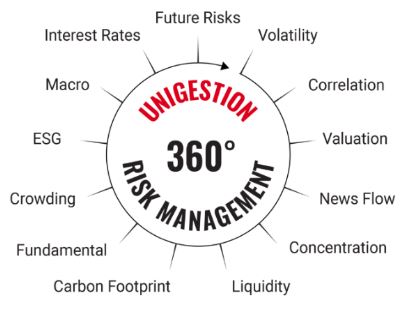
Reducing Market Exposure with an Optimal Hedging Portfolio
Once unrewarded risks are removed, the residual market risk (beta) can be seen as truly undiversifiable. The next question is whether this market risk, which typically ranges between 0.6 and 0.8, is still appropriate given the investor’s specific risk budget. If we assume an expected shortfall for equities of 40%, a residual market exposure of 60% to 80% means a downside risk of between 24% and 32%. Investors who face tighter risk budgets should consider entering into a market risk hedging strategy using futures and options. Hedging an active equity portfolio by selling futures, instead of simply reducing the equity allocation, reduces market exposure but also maintains full outperformance potential. This allows for an improved riskadjusted return profile (Sharpe ratio) compared to a capitalisation-weighted index, such as the MSCI AC World index.

Hedging an active equity portfolio by selling futures, instead of simply reducing the equity allocation, reduces market exposure but also maintains full outperformance potential.

Hedging market risk with futures involves a trade-off between cost and effectiveness. The cost of hedging with futures reflects the slippage from holding and rolling the futures continuously. From a cost perspective, the most liquid indices, such as the S&P 500 and Euro Stoxx 50, tend to be the cheapest to roll, but what if the asset portfolio is very different from these indices? The most effective hedging portfolio corresponds to the maximum achievable correlation between the asset and hedge portfolios, but this can be expensive as, to ensure a high correlation, one may need to roll regional or sector indices with much wider spreads. The optimal hedging portfolio lies somewhere in between. In short, there is no optimal index and investors need to select the portfolio of index futures that exhibits the best trade-off at each roll-over date.
Reducing Timing Risk by Defining the Optimal Hedge Ratio
While tactical hedges may work well around known events, investors face significant timing risk when applying such tactics to hedging market downturns. To reduce this risk, one should first define the strategic hedge ratio. This is particularly important for active low risk strategies as a hedge ratio below 100% can already be excessive.
The minimum variance hedge ratio (MVHR), also known as the optimal hedge ratio, is nothing more than the beta of the hedged portfolio to the hedging portfolio. Even if the beta is broadly stable over the long run, it can vary significantly over a short period. Defining the hedge ratio dynamically is in fact a market timing problem. As shown in Figure 1, while the 20-day rolling beta ranges from 0.12 to 1.0, the long-term strategic MVHR is stable between 0.54 and 0.60. A time window of 3 to 5 years is therefore appropriate to define the strategic hedge ratio.
Figure 1: Rolling Beta vs Optimal Hedging Portfolio
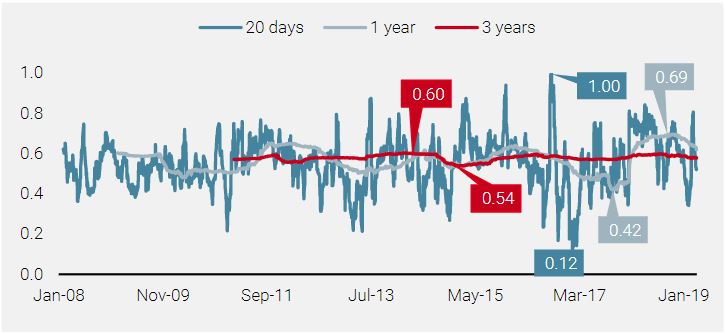
As its name implies, the MVHR is the hedge ratio that exhibits the lowest volatility once combined with the hedged portfolio and so is optimal from a risk perspective. The MVHR is robust in the sense that a 60% level is the minimum risk hedge ratio regardless of whether we consider average levels of risk (Volatility) or extreme ones (Expected Shortfall) (see Figure 2).
Figure 2: Risk and Return Statistics with Various Strategic Hedge Ratios
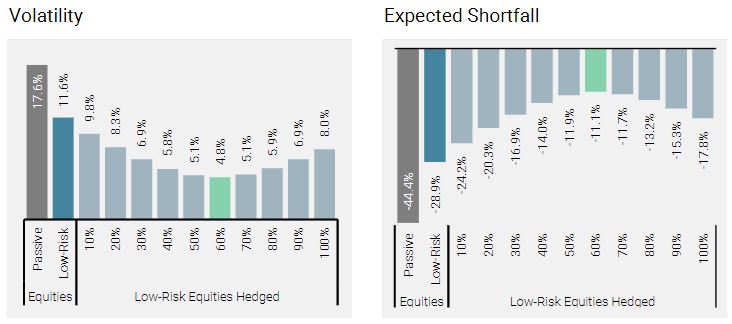
From a return perspective, it depends on the profile of the equity allocation. For low risk equity portfolios, which are usually overweight low risk and quality styles, outperformance tends to be concentrated around periods of high uncertainty, while risk-on markets are usually a source of underperformance, meaning that a hedged portfolio using MVHR can experience the worst drawdowns not only in bear markets but also during bull and mean-reverting markets.

For investors with a defensive equity portfolio, running a strategic under-hedging makes sense from a riskadjusted return perspective.

For investors with a defensive equity allocation, running a strategic under-hedging therefore makes sense from a risk-adjusted return perspective (see Figure 3). Starting from a 40% hedge ratio (i.e. under-hedged by 20%), the risk of the residual beta is more than offset by the performance behaviour of the excess return. Consequently, the “Maximum Sharpe Hedge Ratio” lies around 40%.
Figure 3: Return Risk and Return Statistics with Various Strategic Hedge Ratios
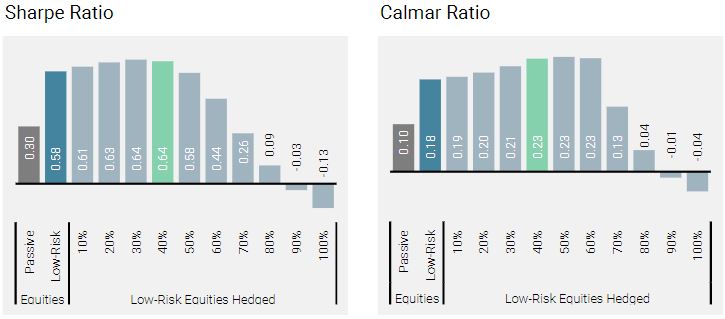
In brief, defining the strategic hedge ratio depends on both the investor’s objective and the style of the equity allocation. For investors with strict risk-targeting preferences, a strategic hedge ratio around the MVHR is appropriate. However, for investors looking to maximise risk-adjusted returns, a residual beta of between 0.2 and 0.3 is optimal.
Dynamic Hedge Ratio: A Macro-based Approach to Market Timing
Market timing is a difficult exercise and should be implemented very cautiously, in particular when it relates to hedging. As a general principle, a dynamic hedging model (‘Dynamic’ in Figure 4) can help to navigate between a return and a risk objective, in our case between the Maximum Sharpe Hedge Ratio (MaxSharpe is 40%) and the Minimum Variance Hedge Ratio (MinRisk is 60%).

The more the economy is supportive for growth assets, the lower the hedge ratio can be reduced down to the MaxSharpe level. Conversely, if the economy is showing signs of recession, the higher it can be increased up to the MinRisk level.

To do this, investors can use macroeconomic nowcasters, which assess the current state of the economy in real time. The more the economy is supportive for growth assets, the lower the hedge ratio can be reduced down to the MaxSharpe level. Conversely, if the economy is showing signs of recession, the higher it can be increased up to the MinRisk level.
Figure 4: Risk and Return Statistics with Various Strategic Hedge Ratios
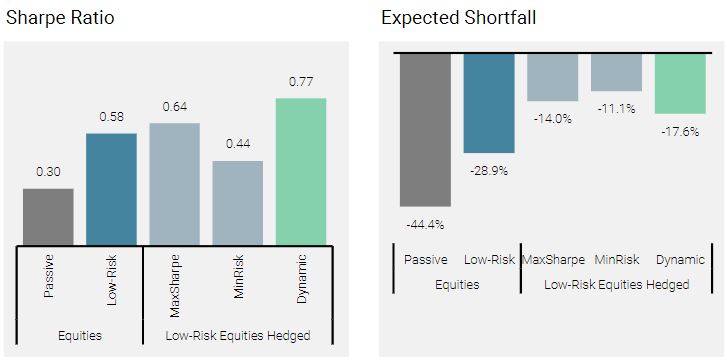
Conclusion
With equity markets at the tail end of a prolonged cycle, the risk of market stress episodes is increasing. There are a number of derivatives hedging strategies available to help investors manage their risk exposures and improve the risk-adjusted returns of their equity allocations. At Unigestion, we offer a range of hedging solutions that can be tailored to investors’ specific requirements. Contact us at clients@unigestion.com for more information.
Important Information
This information is issued by Unigestion (UK) Ltd (“Unigestion”), which is authorised and regulated by the UK Financial Conduct Authority (“FCA”). Unigestion is also registered as an investment adviser with the U.S. Securities and Exchange Commission (“SEC”). This information is intended only for professional clients, institutional clients and eligible counterparties, as defined by the FCA, and qualified purchasers as defined by the SEC and has therefore not been adapted to retail clients.
It must not be published, reproduced, distributed or disclosed (in whole or in part) by recipients to any other person without the prior consent of Unigestion. The information provided should only be considered current as of the date of publication without regard to the date on which you may access the information. Unigestion maintains the right to delete or modify information without prior notice. This presentation is a promotional statement of our investment philosophy and services and does not constitute an offer or solicitation to acquire, sell or subscribe to any securities or financial instruments described or alluded to herein which may be construed as high risk and not readily realisable investments and may experience substantial and sudden loss including total loss of investment. The securities mentioned in this document may not be authorised for public distribution in certain jurisdictions and are not offered or distributed on a public basis in or from any country where such distribution would be prohibited by law. The investments described herein are not suitable for all types of investors. All investors must obtain additional information needed to evaluate a potential investment and provide important disclosures regarding risks, fees and expenses. Investors shall in particular conduct their own analysis of the risks (including any legal, regulatory, tax or other consequence) associated with an investment and should seek independent professional advice.
No separate verification has been made as to the accuracy or completeness of the data included in this presentation, which may have been derived from third party sources, such as fund managers, administrators, custodians and other third party sources. As a result, no representation or warranty, express or implied, is or will be made by Unigestion as regards the information contained herein and no responsibility or liability will be accepted.
The performance figures are based on estimated fees and expenses as well as on the underlying strategy’s estimated performances given by fund managers, administrators, custodians and third party sources at a given date. Past performance is neither guaranteed nor a reliable indicator of future results. The value of investments may go down or up. Where performance is reflected gross of fees, potential investors should be aware that the inclusion of fees, costs and charges will reduce the overall value of performance. An investment with Unigestion, like all investments, contains risks, including the risk of total loss. Unless otherwise stated, the performance data source is Unigestion.
This information is provided to you solely to give you background information relating to Unigestion, certain strategies it implements and currently offers. Before making an investment decision with respect to the strategy discussed herein, potential investors are advised to consult with their tax, legal, ERISA and financial advisors. Note that not all strategies may be available or suitable for investment by U.S. investors.
This document does not purport to be complete and is qualified in its entirety by reference to the more detailed discussions relating to the strategies mentioned. Unigestion has the ability in its sole discretion to change the strategies described herein.
This document is being provided to you on a confidential basis solely to assist you in deciding whether or not to proceed with a further investigation of a strategy or Unigestion. Accordingly, this document may not be reproduced in whole or part, and may not be delivered to any person without the consent of Unigestion.
Nothing set forth herein shall constitute an offer to sell any securities or constitute a solicitation of an offer to purchase any securities. Any such offer to sell or solicitation of an offer to purchase shall be made only by formal offering documents, which include, among others, a confidential offering memorandum, limited partnership agreement (if applicable), investment management agreement (if applicable), operating agreement (if applicable), and related subscription documents (if applicable). Such formal offering documents contain additional information not set forth herein, which such additional information is material to any decision to invest in a strategy.
No information is warranted by Unigestion or its affiliates or subsidiaries as to completeness or accuracy, express or implied, and is subject to change without notice. This document contains forward-looking statements, including observations about markets and industry and regulatory trends as of the original date of this document. Forward-looking statements may be identified by, among other things, the use of words such as “expects,” “anticipates,” “believes,” or “estimates,” or the negatives of these terms, and similar expressions. Forward-looking statements reflect Unigestion’s views as of such date with respect to possible future events. Actual results could differ materially from those in the forward-looking statements as a result of factors beyond a strategy’s or Unigestion’s control. Readers are cautioned not to place undue reliance on such statements. No party has an obligation to update any of the forward-looking statements in this document.
These materials should only be considered current as of the date of publication without regard to the date on which you may receive or access the information. Unigestion maintains the right to delete or modify information without prior notice.
Charts, tables and graphs contained in this document are not intended to be used to assist the reader in determining which securities to buy or sell or when to buy or sell securities.
Return targets or objectives, if any, are used for measurement or comparison purposes and only as a guideline for prospective investors to evaluate a particular investment program’s investment strategies and accompanying information. Targeted returns reflect subjective determinations by Unigestion based on a variety of factors, including, among others, internal modeling, investment strategy, prior performance of similar products (if any), volatility measures, risk tolerance and market conditions. Performance may fluctuate, especially over short periods. Targeted returns should be evaluated over the time period indicated and not over shorter periods. Targeted returns are not intended to be actual performance and should not be relied upon as an indication of actual or future performance.
The past performance of Unigestion, its principals, shareholders, or employees is not indicative of future returns.
Except where otherwise specifically noted, the information contained herein, including performance data and assets under management, relates to the entire affiliated group of Unigestion entities over time including that of Unigestion UK. Such information is intended to provide the reader with background regarding the services, investment strategies and personnel of the Unigestion entities. No guarantee is made that all or any of the individuals involved in generating the performance on behalf the other Unigestion entities will be involved in managing any client account on behalf of Unigestion U.K. More specific information regarding Unigestion UK is set forth herein where indicated and is available on request.
There is no guarantee that Unigestion will be successful in achieving any investment objectives. An investment strategy contains risks, including the risk of complete loss.
The risk management practices and methods described herein are for illustrative purposes only and are subject to modification.
Data and graphical information herein are for information only and may have been derived from third party sources. Unigestion takes reasonable steps to verify, but does not guarantee, the accuracy and completeness of this information. As a result, no representation or warranty, expressed or implied, is or will be made by Unigestion in this respect and no responsibility or liability is or will be accepted. Unless otherwise stated, sources are Unigestion, Bloomberg and Compustat.
For US investors, Unigestion is relying on SEC Rule 15a-6 under the Securities Exchange Act of 1934 regarding exemptions from broker-dealer registration for foreign broker dealers. Foreside Global Services, LLC is acting as the chaperoning broker dealer for Unigestion for the purposes of soliciting and effecting transactions with or for U.S. institutional investors or major U.S. institutional investors.
Backtested or simulated performance is not an indicator of future actual results. The results reflect performance of a strategy not currently offered to any investor and do not represent returns that any investor actually attained. Backtested results are calculated by the retroactive application of a model constructed on the basis of historical data and based on assumptions integral to the model which may or may not be testable and are subject to losses.
Data set used for backtested simulations are all in USD, gross of management fees and net of estimated transaction costs, from 17.01.2008 to 31.03.2019. Passive Equities represents the MSCI All Country World Index TR Net in USD. Low-Risk Equities is a backtested simulation that replicates Unigestion’s expertise in managing risk-based equity strategies on an all country universe. Futures Hedge Portfolio represents a combination of Bloomberg generic futures on S&P 500, Euro STOXX 500 and TOPIX, in USD, gross of fees, net of estimated transaction costs. Options strategies represents backtested simulation in USD, gross of fees, net of estimated transaction costs using Morgan Stanley data.
Changes in these assumptions may have a material impact on the backtested returns presented. Certain assumptions have been made for modeling purposes and are unlikely to be realized. No representations and warranties are made as to the reasonableness of the assumptions. This information is provided for illustrative purposes only. Backtested performance is developed with the benefit of hindsight and has inherent limitations. Specifically, backtested results do not reflect actual trading or the effect of material economic and market factors on the decision-making process. Since trades have not actually been executed, results may have under- or over-compensated for the impact, if any, of certain market factors, such as lack of liquidity, and may not reflect the impact that certain economic or market factors may have had on the decision-making process. Further, backtesting allows the security selection methodology to be adjusted until past returns are maximized. Actual performance may differ significantly from backtested performance.
